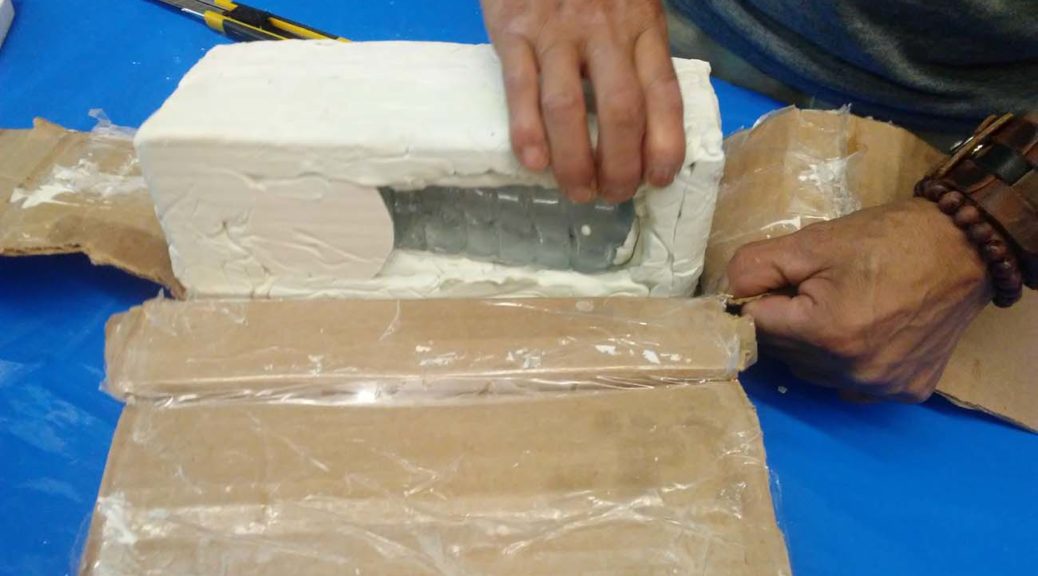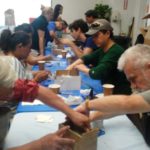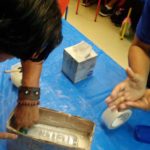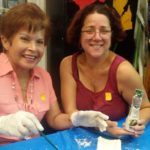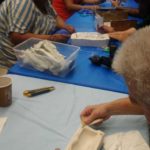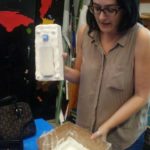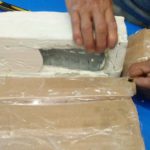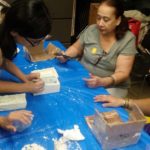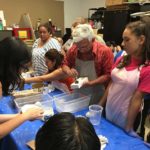En nuestra segunda clase comenzamos a preparar el material para hacer papel desmenuzado dentro del molde de yeso. Recicle el periódico cortándolo en pedazos pequeños con las manos. Es mejor con las manos, para que las fibras se rompan más fácilmente. Dejamos los papeles picados remojándose en agua durante 1 hora y 30 minutos para que las fibras de papel sean más flexibles.
Después pasamos a abrir el molde que se estaba secando de la semana pasada. Sacamos la cama de arcilla del mismo y volvemos el yeso boca abajo sobre la caja de cartón, la lijamos para hacer la superficie lisa y así esté lista para hacer la otra mitad del molde .
Después aplicamos Vaselina en el modelo (botella plástica) y en la superficie del yeso, trabaja como agente aislante entre la botella y el yeso. Al mezclar yeso (1 parte de agua a 2 partes de polvo de yeso) y verter en la caja preparada hicimos la otra mitad del molde de 2 partes.
Mientras el yeso secaba, preparar la pasta de papel para el molde. Mezclamos el papel con agua durante unos 15 minutos. Entonces mezclamos Caolín en él; La arcilla del caolín también se conoce como arcilla de China, este polvo blanco fino se utiliza para hacer el papel más liso, llenando los espacios entre las fibras. Para prepararlo utilizar aproximadamente 4 cucharadas por libra de pulpa. Añadir el caolín a una pinta de agua tibia. Permita que se sienta sin grumos durante dos minutos, luego mezcle. Agregue a su pulpa húmeda (batida) y mezcle bien. El otro componente que utilizamos para el yeso de papel es la Metilcelulosa que es un pegamento suave que viene en polvo. Preparar una solución de la siguiente manera: Disolver 2 cucharadas de Metilcelulosa en una 1/2 taza de agua hirviendo. También se puede usar agua del grifo muy caliente. Revuelva bien hasta que todos los gránulos estén disueltos en el agua; la solución debe ser bastante gruesa y almibarada. A continuación agregar 1 taza de agua muy fría, y mezclar bien.
Cuando la pasta de papel y el pegamento estaban listos, aplicamos vaselina dentro del molde de yeso y ponemos papel de prensa en él y después de aplicar un poco de pegamento en la parte superior del yeso, dejamos a un lado para secar hasta la próxima semana.
La tarea final que hicimos fue elegir una fruta o verdura de tamaños pequeños para hacer un molde de una parte, utilizando el conocimiento aprender haciendo el molde de yeso botella, pero esta vez usamos contenedor de plástico como caja de molde en lugar del cartón. Fue una clase productiva y tan agradable en donde los estudiantes se ayudan mutuamente.
Liene Bosque
In our second class we start to prepare the material to make paper cast inside the plaster mold. We recycle used newspaper cutting it by hand the pages in small pieces, so the fibers are more easily breakable. We let soak in water for 1 hour and 30 min for the paper fibers to be more flexible.
Afterwards we moved on to open the mold that was drying from last week and take the clay bed off it and turn the plaster upside down on the cardboard box, we sand it to make smooth surface, so we could do the other half of the mold. After we had to apply Vaseline on the model (plastic bottle) and on the plaster surface, it works as release agent to the next plaster pouring. By mixing plaster (1part of water to 2 parts of plaster powder) and pouring into the prepared box we made the other half of the 2 part mold.
While plaster was curing we went back prepare the paper pulp for casting. We blend paper with water for about 15 minutes. Then we mix Kaolin into it; Kaolin Clay is also known as China clay, this fine white powder is used to make paper more smooth, filling the gaps between the fibers. To prepare it use approximately 4 tablespoons per pound of pulp. Add kaolin to a pint of lukewarm water. Allow to sit undisturbed for two minute, then mix. Add to your wet (beaten) pulp and mix thoroughly. Other component we use for paper cast is Methyl Cellulose that is a mild glue that come in powder. Make up a solution in the following manner: Dissolve 2 tablespoons of methyl cellulose in a 1/2 cup of boiling water. One can also use very hot tap water. Stir thoroughly until all the granules have absorbed water; the solution should be fairly thick and syrupy. Next add 1 cup of very cold water, and mix thoroughly.
When the paper pulp and glue was ready we applied Vaseline inside the plaster mold and press paper pulp into it and after applying a bit of glue on top of the cast, we set aside to dry until next week.
The final task we did was to choose an fruit or vegetable of small sizes to do an one part mold, using the knowledge learn by making the bottle plaster mold, but this time we used plastic container as mold box instead of the cardboard. It was a productive class and so nice that the students are all helping each other.
Liene Bosque

 New New Yorkers
New New Yorkers